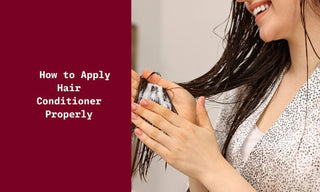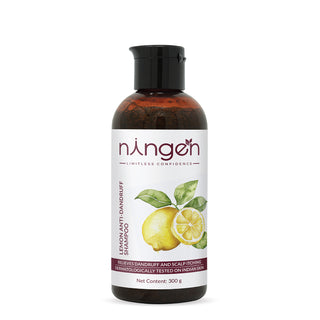Imagine running your fingers through silky, smooth hair every day; it’s a dream many of us share. Hair conditioner is a key player in achieving that luscious look, yet many people use it incorrectly. Understanding how to apply hair conditioner properly can transform your hair care routine from mediocre to extraordinary. This article will outline five essential tips for applying hair conditioner correctly. From choosing the right product for your specific hair type to mastering the application technique, each step is crucial for attaining enviable results. Additionally, we’ll debunk common myths and explore various conditioning methods to ensure you don't just survive your hair care routine, but thrive in it.
In This Article;
- Why Should You Use Hair Conditioner?
- Different Types Of Hair Conditioners
- How to Apply Hair Conditioner Properly: Step by Step
- 5 Tips for Hair Conditioner Application
- Common Myths About Hair Conditioner
- The Bottom Line
- TL;DR
- Frequently Asked Questions
Why Should You Use Hair Conditioner?
Hair conditioner is an essential part of any effective hair care routine. It’s more than just an added step; it's a transformative experience for your hair. The conditioner helps to restore moisture that might be lost during shampooing, smooths frizzy hair, and adds a protective layer to the hair shaft against environmental damage. Whether you have dry hair or oily hair, using the right conditioner can prevent hair breakage and make your hair soft and manageable. Plus, it can significantly reduce the brittleness in damaged hair, leaving it with a silky and shiny appearance. So, incorporating a good conditioner into your regimen is crucial for healthier and vibrant hair.
Different Types Of Hair Conditioners
Conditioners are an essential part of hair care, helping to hydrate, protect, and improve manageability. Different types of conditioners cater to specific hair needs, ensuring your hair stays healthy and vibrant. Here’s a breakdown of the most common types:
1. Rinse-Out Conditioners
These are the most commonly used conditioners. Applied after shampooing, they provide hydration, detangle hair, and add softness and shine. Suitable for daily use, they are ideal for normal to slightly dry hair types.
2. Leave-In Conditioners
Lightweight and non-greasy, leave-in conditioners are applied to damp hair and left in without rinsing. They provide continuous hydration, heat protection, and enhanced manageability. Ideal for dry, frizzy, or curly hair.
3. Deep Conditioners
Packed with intense moisturizing agents, deep conditioners are designed for periodic use to repair and restore severely damaged or dry hair. They penetrate deeply, improving elasticity and strength while reducing breakage.
4. Protein Conditioners
These conditioners fortify hair with proteins to repair damage caused by heat, chemicals, or environmental stressors. Perfect for weakened or brittle hair, they rebuild structure and reduce split ends.
5. Moisturizing Conditioners
Formulated to infuse hair with hydration, moisturizing conditioners are ideal for dry, curly, or coarse hair. They prevent dryness, add shine, and improve overall hair health.
6. Color-Safe Conditioners
Designed for chemically treated or colored hair, these conditioners help lock in color and protect against fading. They also nourish hair that may have been damaged during the coloring process.
7. Cleansing Conditioners (Co-Wash)
A combination of cleanser and conditioner, cleansing conditioners are gentle and help clean the hair without stripping natural oils. They are popular among those with curly or textured hair.
8. Volumizing Conditioners
Lightweight and non-heavy, these conditioners are great for fine or limp hair. They add body and lift while preventing greasiness.
9. Silicone-Free Conditioners
Free from silicones, these conditioners are preferred for those who want a more natural approach to hair care. They leave hair lightweight and bouncy without the buildup of synthetic agents.

How to Apply Hair Conditioner Properly: Step by Step
1. Start with Clean Hair
- Wash your hair thoroughly with shampoo, ensuring you remove all dirt, oil, and product buildup.
- Rinse out the shampoo completely to prepare your hair for the conditioner.
2. Squeeze Out Excess Water
- Gently wring out your hair or pat it with a towel to remove excess water.
- Avoid applying conditioner to soaking-wet hair, as it can dilute the product and reduce its effectiveness.
3. Take the Right Amount
- Dispense a suitable amount of conditioner into your hand.
- For short hair: Use a nickel-sized amount.
- For medium-length hair: Use a quarter-sized amount.
- For long hair: Use more as needed.
4. Apply to the Lengths and Ends
- Focus on the mid-lengths and ends of your hair, where moisture is needed most.
- Avoid applying conditioner directly to your scalp, as it can make the roots greasy.
5. Distribute Evenly
- Use your fingers or a wide-toothed comb to evenly distribute the conditioner through your hair.
- Ensure every strand is coated for maximum benefit.
6. Let It Sit
- Leave the conditioner on your hair for 2-5 minutes or as instructed on the product label.
- Allowing it to sit ensures the active ingredients can penetrate and nourish your hair.
7. Rinse Thoroughly
- Use lukewarm water to rinse out the conditioner completely.
- Ensure there’s no residue left, as it can weigh down your hair.
8. Gently Towel Dry
- Pat your hair dry with a soft towel instead of rubbing to avoid frizz and breakage.
- Style as usual for smooth and manageable hair.
Pro Tip:
For added hydration, consider using a leave-in conditioner or hair serum on damp hair after rinsing out the conditioner.
Also read: The science of hair conditioners and how it works?
5 Tips for Hair Conditioner Application
1. Choose the Right Conditioner for Your Hair Type
Not all conditioners are created equal, and what works for someone else might not work for you. Whether you have frizzy, coarse hair or fine, oily hair, selecting a conditioner that suits your hair type is crucial. For instance, a deep conditioner is ideal for dry hair, while a lightweight leave-in conditioner caters to oily hair, adding moisture without greasiness. Consider your hair's needs and choose accordingly for optimal results.
2. Use an Appropriate Quantity of Conditioner
Less can sometimes be more when it comes to conditioner. Applying too much can weigh hair down and make it greasy. For shorter hair, a coin-sized amount suffices, while longer hair might need slightly more. Focus on the ends, where hair damage usually accumulates. By using just the right amount, you maintain your hair’s natural volume and texture.
3. Cleanse Your Hair Thoroughly Before Application
Ensuring your hair is clean can help the conditioner work effectively. Start by washing your hair with shampoo to remove dirt and excess oils. This pre-cleanse stage opens the hair cuticles, allowing conditioner penetration that nurtures the hair strand deeply. Rinse thoroughly with cool water to unveil softer, more manageable locks.
4. Apply Conditioner Evenly on Wet Hair
For your conditioner to deliver its full potential, your hair should be damp, not dripping. Wet hair helps the formula glide on smoothly and coat each hair shaft evenly. After wringing out excess water, spread the conditioner from mid-length to the ends. Using a wide-toothed comb can further distribute the product, minimizing hair breakage and enhancing absorption.
5. Use a Wide-Toothed Comb for Distribution
Using a wide-toothed comb ensures even distribution of hair care products like conditioners or serums. It prevents breakage and minimizes tangles, especially on damp hair. This gentle approach enhances absorption and keeps your hair smooth, healthy, and manageable
By embracing these tips, you’ll elevate your hair care routine and transform your hair into a crowning glory that radiates health and vitality.

Common Myths About Hair Conditioner
When it comes to hair conditioner, misconceptions abound. Let's debunk a few common myths that might be affecting your hair care routine.
Myth 1: Conditioner is Only for Dry Hair.
Conditioner benefits all hair types, not just dry hair. While it's excellent for restoring moisture to brittle hair, it can also protect oily hair from environmental damage and prevent hair breakage.
Myth 2: Conditioner Makes Your Hair Greasy.
If used correctly, conditioner will not make your hair greasy. The key is applying a coin-sized amount, focusing on the hair shaft and ends rather than the scalp.
Myth 3: You Should Skip Conditioner if You Have Shorter Hair.
Even shorter hair can suffer from damage. Conditioner helps keep your locks soft and manageable, regardless of length.
Myth 4: Leave-In Conditioner is Unnecessary.
For frizzy hair, a Leave-In Conditioner can act as a protective layer against humidity, making it an invaluable addition to any hair care routine.
Myth 5: Deep Conditioner is Only for Damaged Hair.
A deep conditioner is ideal for providing extra nourishment, not only for damaged hair but also for maintaining the health of hair cuticles and enhancing hair softness.
Don't let these myths fool you; using conditioner properly can make a world of difference in achieving healthy, gorgeous hair!
Also read: The beginners guide on how to use hair conditioners.
The Bottom Line
Achieving healthy, manageable, and luscious hair is within your reach with the proper use of hair conditioner. By understanding your hair type, choosing the right conditioner, and following the correct application techniques, you can unlock the full potential of this essential hair care product. Whether it's a rinse-out conditioner for daily care or a deep conditioner for added nourishment, incorporating the right product into your routine can transform your hair.
Don't let common myths hold you back—embrace these tips for a thriving hair care journey and enjoy the confidence of beautiful, well-maintained locks.
TL;DR
Hair conditioner is a vital part of hair care that hydrates, protects, and improves hair texture. Choosing the right type for your hair and applying it properly can make a significant difference. From rinse-out to leave-in and deep conditioners, each type serves specific needs. Follow steps like cleaning your hair, applying the right amount, focusing on mid-lengths and ends, and rinsing thoroughly to maximize its benefits. Avoid common myths and use conditioners wisely for healthy, manageable hair.
Frequently Asked Questions
Q1. What is the best way to apply hair conditioner?
Apply conditioner to clean, damp hair, focusing on the mid-lengths and ends. Avoid the scalp, distribute evenly with a wide-toothed comb, and rinse thoroughly.
Q2. How often should I use hair conditioner?
Most hair types benefit from conditioner after every wash. Adjust frequency based on your hair’s needs and the type of conditioner used.
Q3. What is the difference between rinse-out and leave-in conditioner?
Rinse-out conditioner is applied after shampooing and rinsed out, while leave-in conditioner is applied to damp hair and left in for continuous hydration.
Q4. Can I use a deep conditioner every day?
No, deep conditioners are intensive treatments and are best used once a week or as needed for severely dry or damaged hair.
Q5. Should I apply conditioner to my scalp?
It’s best to avoid the scalp to prevent greasiness. Focus on the lengths and ends where hair is most damaged and dry.
Q6. What type of conditioner is best for dry hair?
Moisturizing or deep conditioners are ideal for dry hair as they restore hydration and reduce brittleness.
Q7. How long should I leave conditioner in my hair?
Leave the conditioner in for 2-5 minutes or follow the instructions on the product label for optimal results.
Q8. Can conditioner help with frizzy hair?
Yes, conditioners, especially leave-in types, can help tame frizz by smoothing the hair cuticle and providing moisture.
Q9. Is it okay to use conditioner without shampoo?
Cleansing conditioners or co-washes are designed for this purpose and can clean and condition hair simultaneously.
Q10. Can conditioner cause hair loss?
Conditioner itself doesn’t cause hair loss. However, improper use, such as applying to the scalp, may clog pores and contribute to hair issues.









